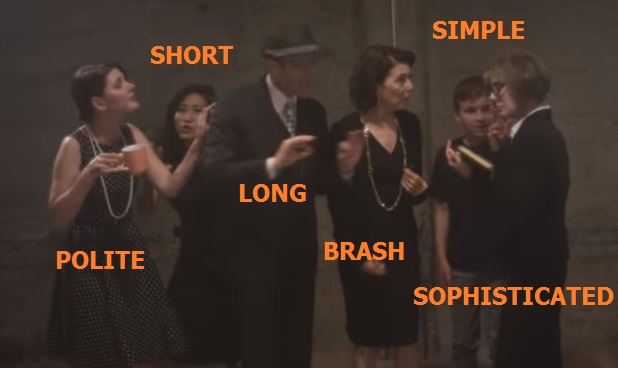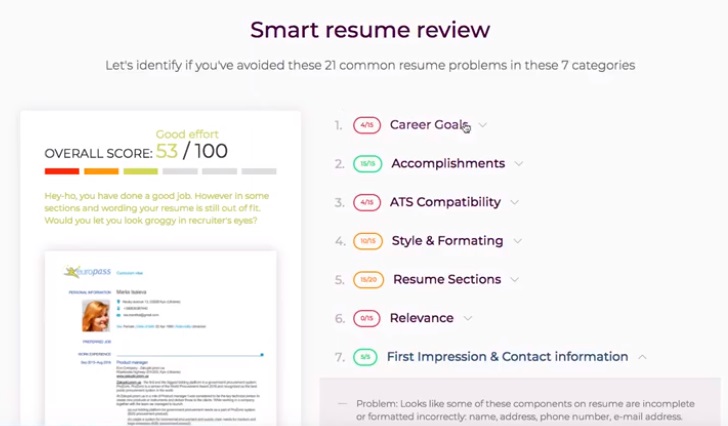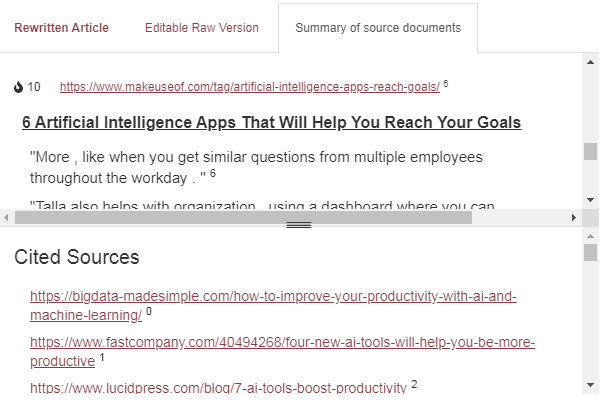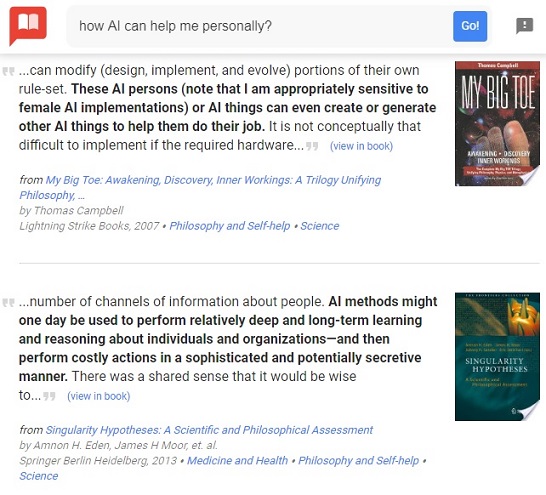This is part 4 of Quickstart Guide: How to boost your personal productivity with A.I. tools
As you might have noticed, a few of the tools above are trying go beyond giving you personalized information on demand. These systems proactively monitor some aspects of your performance, and make suggestions when it deems appropriate, not just when when you ask for it. It’s like being warned about things you didn’t even know to watch out for in the first place – how cool is that?!
… writing
Writing is what we do all the time. To paraphrase Daniel Pink, “To write is human”. Even if you are not an author, a blogger or a copywriter, you are likely to write a hundred of words per day in a form of emails, product reviews or social media posts. (This paragraph so far is 50 words. You see – hundred words is not that much after all.) And even if you are not making living with your writing, you certainly are making an impression with it.
Notwithstanding the popular advice, books are judged by their covers, even if subconsciously so. Well, grammar is the “cover” of your writing, and likely to shape that first impression people will get from it. Hopefully, the content of your writing is so brilliant that any grammar imperfections don’t really matter, but why not turn even the first impression into a favorable one? Especially since Grammarly makes it so easy. You just install a plugin for you browser, and from that point on all your writing will get loving oversight and nudges. Not in a typical terse “my way or highway” type of correction, but offering detailed explanation of the reasoning behind the suggestion, so that you actually grow as a writer, not grow dependent on the safety net.

Bonus: The best part is that you can now get into the flow with your writing, without worrying about misspelled words and tense alignment.
Now, if the grammar is the ice-breaker, the tone is the deal-closer. ‘Cause there is a reason you write. You are soliciting a response, an action. A resonance. You need to fine-tune your tone for your audience, to find that perfect balance of your message being concise but provide enough context, vivid but easy to read, polite but clear. That’s what Boomerang Respondable is trained to do. As a plugin to your favorite email program, it scores your writing along these three dimensions – word count, reading level and politeness – and evaluates the likelihood of you getting a response. And all this in real-time, as you type, so you can quickly massage the message right into the sweet spot.

Bonus: Yet again, getting into the flow of writing is all about silencing that inner critic – or at least make the criticism constructive.
Writing is a skill, so you’ll get better with practice. But then, there are pieces in a certain genre that you don’t get to write very often – but every time you do that, you’d better get it right. Resume, for example. The job of the resume is to get you invited to the interview (pretty big job, eh?), and it has only about 10 seconds to do it (that’s how much on average a recruiter spends on a resume). There are certain pitfalls to avoid in this high-stake fast-paced game, and Smart Resume Review is designed specifically to guide you around them. Just upload your resume, and it will spot the potential fatal mistakes.

Bonus: AI Resume Generator from the same toolkit allows you to avoid these mistakes in the first place.
And in case you write something really epic – like a novel, or role-playing game campaigns, or anything that amounts to creating a (mini-)world – check out Notebook.ai. It not only offers a structure to the process of creating a world, but uses its smarts to make the world more complete and consistent. For example, it automatically completes characters’ dossiers with information derived from the dossiers of their relatives. As another example, it can recognize that some information is missing from the content and ask the author about it. It’s promised to “soon be able to ask deeper and more stimulating questions, find consistency problems, and come up with writing prompts tailored to you: set in your world, starring your characters, locations, and items.” Writer’s block, begone.

Bonus: You can share your worlds (or Universes, in Notebook.ai parlance) with your team. Or even with your players – and keep the surprises secret with per-page privacy controls.
… searching for the diamond
Speaking of once-(or so)-in-a-lifetime projects – while you certainly should make a point in experiencing them fully, you shouldn’t let your lack of previous experience have dramatic negative effect the outcome. Get some guidance, but put your own spin on it.
Take for example finding the perfect diamond engagement ring. The ring might turn something to be passed on to the generations to come, or something that would ruin your marriage – and there are plenty of examples for either outcome. While staying away from fake diamonds would most likely delist the ring as a probable reason for divorce, becoming a piece of heritage is more nuanced. The thing is that the overall experience of a diamond is way more than just its position on 4C (color-clarity-cut-carat) landscape – it’s also about fluorescence, inclusion position, table percentage and more than a dozen more quality factors. And there could be thousand of diamonds to choose from – even after the price range is capped!
The pure dimensionality of the search task amplified with its importance would easily overwhelm the bravest of us… Luckily, there is Rosi Intelligent Diamond Search, the diamond-picking algorithm based on IBM’s Watson (yes, the same Watson that won Jeopardy back in 2011 and since have been trained in many other things). Given your budget and the aspect on which you are the most flexible (out of “value-size-quality”), ROSI will surface a few optimal choices for you. Optimal in what sense, you ask? That’s where the A.I. plays its part. “…ROSI [was taught] to balance all those quality factors. We refined the algorithm with human expertise and generations of professional diamond-buying experience. We trained ROSI in competition with diamond dealer after diamond dealer until ROSI knew how important each factor was for every single diamond shape.” So, it amounts to having a top diamond-buying expert to find you a diamond according to your budget and basic preferences – among dozens of thousands of diamond in a matter of seconds. How could you NOT try this??

Bonus: If you already have found a diamond you like, you can give ROSI the GIA report and the price, and challenge it to find you a better one. Also, its expertise allows you to venture beyond classic round shape (with the safe bet of hearts’n’arrows cuts) into the many other fancy shapes – and still ace it!
… doing research
But for some people, sifting through massive amounts of information in search of gems is a regular activity – and one that involves data structured much less than [diamond spec]. Take the task of researching a topic and preparing a reading list. Even skillful professional researcher could spend 2-4 weeks on that at a time, and self-reported accuracy of the resulting list is a modest 70% – leaving a good chance for an important knowledge to be left out. No wonder – just in the science, technology and medicine domains alone, about 3000 papers are published every day. And here is the dark side of this massive productivity – 50% of published papers are read by less than 5 people. Luckily, A.I. now can read and understand them too.
Iris.ai is on the mission of recovering all this knowledge lost in the digital equivalent of dusty drawers. Having created what they call “fingerprints” of over 83 million Open Access papers, they can almost instantaneously match them against a “fingerprints” of a paper you found interesting. And it won’t just dump all the matched papers on you. It will organize them in themes and sub-themes, effectively creating a map of the territory you are exploring, the map that could help you identify adjacent topics and interdisciplinary intersections – where new opportunities usually live. You can navigate the map visually, drill-down into sub-themes all the way to individual papers, bookmark the papers, and refine the list further by filtering out concepts that seem irrelevant. The result? That 2-4 weeks process condensed into 2-4 days, with the accuracy of the produced reading list raising to 85%.

Bonus: Don’t have a paper to seed the search? No problem. Iris.ai can start with a “fingerprint” of your own description of the topic – although, for a good “fingerprint” the description should be 300-500 words long and contain as much details, explanations and background as possible. Or you can even start with a relevant TED talk!
Researching online articles rather than scientific papers? Let AI Writer help you out! It’s actually positioned as an automatic online content generator, but my experience with that part of the service was entertaining rather than productive. However, the summary of source documents is excellent! Of course, you could just google the topic of your research, but I find AI Writer’s results more relevant. Besides, you can control the size of the summary for quicker skimming.

Bonus: At some point, I expected this AI tool generate not only unique text, but actually something worth publishing.
Speaking of Google – its Talk to Books service offers less methodical approach to discovering knowledge in published materials, but one that is not restricted to online publications. Here, you can submit a question (or any phrase, for that matter) and get back a list of relevant passages from books. Not a definitive list by any measure, but rather an additional fun way to explore the topic.

Bonus: In one click you land on Google Book page, where you can further explore related books.
And for the ultimate boost, see how to delegate to A.I. … →